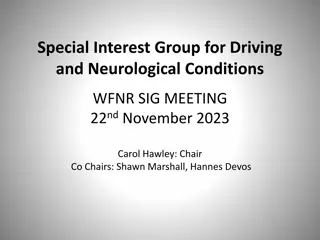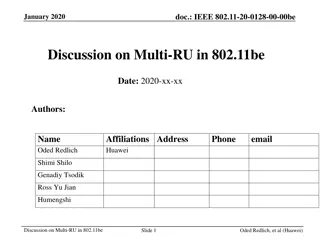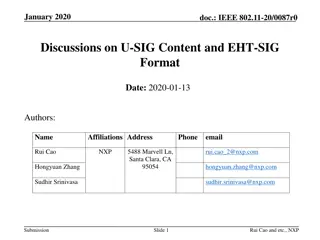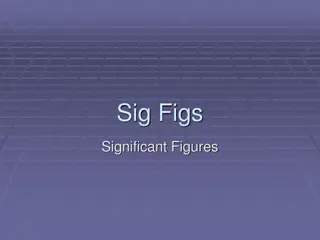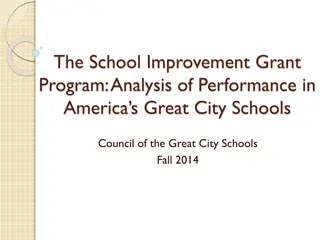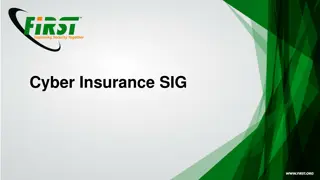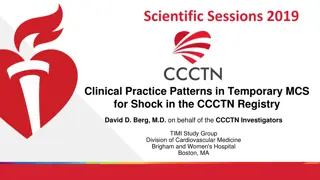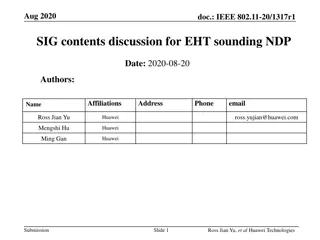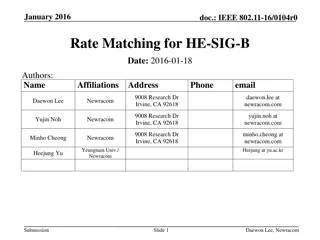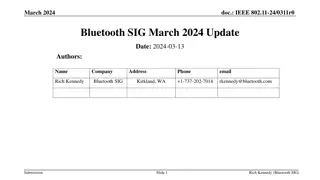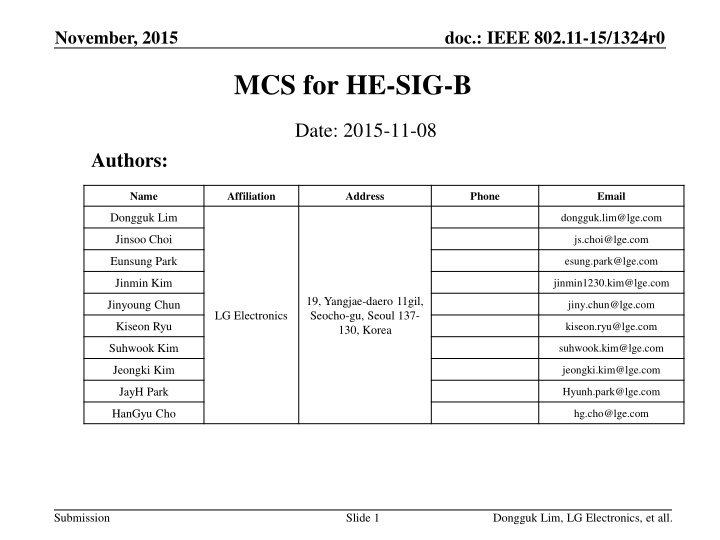
IEEE 802.11-15/1324r0 - MCS for HE-SIG-B and Author Affiliations
This document dated November 2015 discusses IEEE 802.11-15/1324r0, focusing on the MCS for HE-SIG-B. The document lists multiple authors from various affiliations such as LG Electronics, Broadcom, Intel, Marvell, and more. It provides valuable insights into wireless communication standards and advancements in the field.
Download Presentation

Please find below an Image/Link to download the presentation.
The content on the website is provided AS IS for your information and personal use only. It may not be sold, licensed, or shared on other websites without obtaining consent from the author. If you encounter any issues during the download, it is possible that the publisher has removed the file from their server.
You are allowed to download the files provided on this website for personal or commercial use, subject to the condition that they are used lawfully. All files are the property of their respective owners.
The content on the website is provided AS IS for your information and personal use only. It may not be sold, licensed, or shared on other websites without obtaining consent from the author.
E N D
Presentation Transcript
November, 2015 doc.: IEEE 802.11-15/1324r0 MCS for HE-SIG-B Date: 2015-11-08 Authors: Name Affiliation Address Phone Email Dongguk Lim dongguk.lim@lge.com Jinsoo Choi js.choi@lge.com Eunsung Park esung.park@lge.com Jinmin Kim jinmin1230.kim@lge.com 19, Yangjae-daero 11gil, Seocho-gu, Seoul 137- 130, Korea Jinyoung Chun jiny.chun@lge.com LG Electronics Kiseon Ryu kiseon.ryu@lge.com Suhwook Kim suhwook.kim@lge.com Jeongki Kim jeongki.kim@lge.com JayH Park Hyunh.park@lge.com HanGyu Cho hg.cho@lge.com Submission Slide 1 Dongguk Lim, LG Electronics, et all.
November, 2015 doc.: IEEE 802.11-15/1324r0 Authors (continued) Name Ron Porat Sriram Venkateswaran Matthew Fischer Leo Montreuil Andrew Blanksby Vinko Erceg Affiliation Address Phone Email rporat@broadcom.com mfischer@broadcom.com Broadcom Robert Stacey robert.stacey@intel.com Shahrnaz Azizi shahrnaz.azizi@intel.com Po-Kai Huang po-kai.huang@intel.com Qinghua Li 2111 NE 25th Ave, Hillsboro OR 97124, USA quinghua.li@intel.com Xiaogang Chen +1-503-724-893 xiaogang.c.chen@intel.com Intel Chitto Ghosh chittabrata.ghosh@intel.com Laurent Cariou laurent.cariou@intel.com Yaron Alpert yaron.alpert@intel.com Assaf Gurevitz Ilan Sutskover assaf.gurevitz@intel.com ilan.sutskover@intel.com Submission Slide 2 Dongguk Lim, LG Electronics, et all.
November, 2015 doc.: IEEE 802.11-15/1324r0 Authors (continued) Name Affiliation Address Phone Email Hongyuan Zhang hongyuan@marvell.com Yakun Sun yakunsun@marvell.com Lei Wang Leileiw@marvell.com Liwen Chu liwenchu@marvell.com Jinjing Jiang jinjing@marvell.com Yan Zhang yzhang@marvell.com Rui Cao ruicao@marvell.com 5488 Marvell Lane, Santa Clara, CA, 95054 Sudhir Srinivasa Marvell 408-222-2500 sudhirs@marvell.com Bo Yu boyu@marvell.com Saga Tamhane sagar@marvell.com Mao Yu my@marvel..com Xiayu Zheng xzheng@marvell.com Christian Berger crberger@marvell.com Niranjan Grandhe ngrandhe@marvell.com Hui-Ling Lou hlou@marvell.com Submission Slide 3 Dongguk Lim, LG Electronics, et all.
November, 2015 doc.: IEEE 802.11-15/1324r0 Authors (continued) Name Affiliation Address Phone Email No. 1 Dusing 1st Road, Hsinchu, Taiwan James Yee +886-3-567-0766 james.yee@mediatek.com Alan Jauh alan.jauh@mediatek.com chinghwa.yu@mediatek.co m frank.hsu@mediatek.com Mediatek Chingwa Hu Frank Hsu 2860 Junction Ave, San Jose, CA 95134, USA Thomas Pare +1-408-526-1899 thomas.pare@mediatek.com chaochun.wang@mediatek.c om james.wang@mediatek.com ChaoChun Wang James Wang Mediatek USA Jianhan Liu Jianhan.Liu@mediatek.com Tianyu Wu tianyu.wu@mediatek.com Zhou Lan Zhou.lan@mediaTek.com russell.huang@mediatek.co m Russell Huang Joonsuk Kim joonsuk@apple.com mujtaba@apple.com Aon Mujtaba Guoqing Li Apple guoqing_li@apple.com Eric Wong ericwong@apple.com Chris Hartman chartman@apple.com Submission Slide 4 Dongguk Lim, LG Electronics, et all.
November, 2015 doc.: IEEE 802.11-15/1324r0 Authors (continued) Name Affiliation Address Phone Email Peter Loc peterloc@iwirelesstech.com F1-17, Huawei Base, Bantian, Shenzhen 5B-N8, No.2222 Xinjinqiao Road, Pudong, Shanghai F1-17, Huawei Base, Bantian, Shenzhen 5B-N8, No.2222 Xinjinqiao Road, Pudong, Shanghai 5B-N8, No.2222 Xinjinqiao Road, Pudong, Shanghai 10180 Telesis Court, Suite 365, San Diego, CA 92121 NA 303 Terry Fox, Suite 400 Kanata, Ottawa, Canada F1-17, Huawei Base, Bantian, Shenzhen 10180 Telesis Court, Suite 365, San Diego, CA 92121 NA 303 Terry Fox, Suite 400 Kanata, Ottawa, Canada 5B-N8, No.2222 Xinjinqiao Road, Pudong, Shanghai 303 Terry Fox, Suite 400 Kanata, Ottawa, Canada F1-17, Huawei Base, Bantian, Shenzhen F1-17, Huawei Base, Bantian, Shenzhen Le Liu liule@huawei.com +86-18601656691 Jun Luo jun.l@huawei.com Yi Luo Roy.luoyi@huawei.com +86-18665891036 Yingpei Lin linyingpei@huawei.com Jiyong Pang pangjiyong@huawei.com Zhigang Rong zhigang.rong@huawei.com Rob Sun Rob.Sun@huawei.com Huawei David X. Yang david.yangxun@huawei.com Yunsong Yang yangyunsong@huawei.com Junghoon Suh Junghoon.Suh@huawei.com Jiayin Zhang zhangjiayin@huawei.com +86-18601656691 Edward Au edward.ks.au@huawei.com Teyan Chen chenteyan@huawei.com Yunbo Li liyunbo@huawei.com Submission Slide 5 Dongguk Lim, LG Electronics, et all.
November, 2015 doc.: IEEE 802.11-15/1324r0 Name Affiliation Address Innovation Park, Cambridge CB4 0DS (U.K.) Maetan 3-dong; Yongtong-Gu Suwon; South Korea 1301, E. Lookout Dr, Richardson TX 75070 Innovation Park, Cambridge CB4 0DS (U.K.) 1301, E. Lookout Dr, Richardson TX 75070 Maetan 3-dong; Yongtong-Gu Suwon; South Korea Phone Email Fei Tong f.tong@samsung.com +44 1223 434633 Hyunjeong Kang hyunjeong.kang@samsung.com +82-31-279-9028 Kaushik Josiam k.josiam@samsung.com (972) 761 7437 Samsung Mark Rison m.rison@samsung.com +44 1223 434600 Rakesh Taori rakesh.taori@samsung.com (972) 761 7470 Sanghyun Chang s29.chang@samsung.com +82-10-8864-1751 Yasushi Takatori takatori.yasushi@lab.ntt.co.jp Yasuhiko Inoue inoue.yasuhiko@lab.ntt.co.jp Shoko Shinohara Shinohara.shoko@lab.ntt.co.jp 1-1 Hikari-no-oka, Yokosuka, Kanagawa 239-0847 Japan NTT Yusuke Asai asai.yusuke@lab.ntt.co.jp Koichi Ishihara ishihara.koichi@lab.ntt.co.jp Junichi Iwatani Iwatani.junichi@lab.ntt.co.jp 3-6, Hikarinooka, Yokosuka- shi, Kanagawa, 239-8536, Japan Akira Yamada yamadaakira@nttdocomo.com watanabe@docomoinnovations. com hpapadopoulos@docomoinnov ations.com NTT DOCOMO Fujio Watanabe 3240 Hillview Ave, Palo Alto, CA 94304 Haralabos Papadopoulos Submission Slide 6 Dongguk Lim, LG Electronics, et all.
November, 2015 doc.: IEEE 802.11-15/1324r0 Authors (continued) Name Affiliation Address Phone Email Masahito Mori Masahito.Mori@jp.sony.com Yusuke Tanaka YusukeC.Tanaka@jp.sony.com Yuichi Morioka Sony Corp. Yuichi.Morioka@jp.sony.com Kazuyuki Sakoda Kazuyuki.Sakoda@am.sony.com William Carney William.Carney@am.sony.com #9 Wuxingduan, Xifeng Rd., Xi'an, China Bo Sun sun.bo1@zte.com.cn Kaiying Lv lv.kaiying@zte.com.cn ZTE Yonggang Fang yfang@ztetx.com Ke Yao yao.ke5@zte.com.cn Weimin Xing xing.weimin@zte.com.cn 170 W Tasman Dr, San Jose, CA 95134 Brian Hart brianh@cisco.com Cisco Systems Pooya Monajemi pmonajem@cisco.com 1700 Technology Drive San Jose, CA 95110, USA 5775 Morehouse Dr. San Diego, CA, USA 5775 Morehouse Dr. San Diego, CA, USA 1700 Technology Drive San Jose, CA 95110, USA 1700 Technology Drive San Jose, CA 95110, USA rolfv@qca.qualcomm.com Rolf De Vegt svverman@qti.qualcomm.com Sameer Vermani Qualcomm smerlin@qti.qualcomm.com Simone Merlin tyucek@qca.qualcomm.com Tevfik Yucek vkjones@qca.qualcomm.com VK Jones Submission Slide 7 Dongguk Lim, LG Electronics, et all.
November, 2015 doc.: IEEE 802.11-15/1324r0 Authors (continued) Name Affiliation Address Phone Email 5775 Morehouse Dr. San Diego, CA, USA 5775 Morehouse Dr. San Diego, CA, USA 1700 Technology Drive San Jose, CA 95110, USA 5775 Morehouse Dr. San Diego, CA, USA 5775 Morehouse Dr. San Diego, CA, USA Straatweg 66-S Breukelen, 3621 BR Netherlands 5775 Morehouse Dr. San Diego, CA, USA 5775 Morehouse Dr. San Diego, CA, USA 1700 Technology Drive San Jose, CA 95110, USA 5775 Morehouse Dr. San Diego, CA, USA 5775 Morehouse Dr. San Diego, CA, USA 5775 Morehouse Dr. San Diego, CA, USA Straatweg 66-S Breukelen, 3621 BR Netherlands 2100 Lakeside Blvd, Suite 475, RichardsonTX, USA 1060 Rincon Circle San Jose CA 95131, USA Straatweg 66-S Breukelen, 3621 BR Netherlands Lin Yang linyang@qti.qualcomm.com Bin Tian btian@qti.qualcomm.com Youhan Kim youhank@qca.qualcomm.com Sameer Vermani svverman@qti.qualcomm.com Alice Chen alicel@qti.qualcomm.com Albert Van Zelst allert@qti.qualcomm.com Alfred Asterjadhi aasterja@qti.qualcomm.com Arjun Bharadwaj arjunb@qti.qualcomm.com Qualcomm Carlos Aldana caldana@qca.qualcomm.com George Cherian gcherian@qti.qualcomm.com Gwendolyn Barriac gbarriac@qti.qualcomm.com Hemanth Sampath hsampath@qti.qualcomm.com Menzo Wentink mwentink@qti.qualcomm.com Naveen Kakani nkakani@qti.qualcomm.com Raja Banerjea rajab@qit.qualcomm.com Richard Van Nee rvannee@qti.qualcomm.com Submission Slide 8 Dongguk Lim, LG Electronics, et all.
November, 2015 doc.: IEEE 802.11-15/1324r0 Introduction We have decided how to construct the HE-SIG-B and what encoding method for HE-SIG-B to be used in given BW [1] But, MCS values for HE-SIG-B are not yet defined so far In 11ac, only MCS0 was used to VHT-SIG-A field for robust transmission including 3rd party STAs (similar in HE-SIG-A as well now) However, HE-SIG-B only conveys specific information of recipient STAs that means the possibility of using higher MCSs for efficiency We can consider using variable MCSs on HE-SIG-B according to STA s status. In this contribution, we discuss MCS set for effective HE-SIG-B transmission Submission Slide 9 Dongguk Lim, LG Electronics, et all.
November, 2015 doc.: IEEE 802.11-15/1324r0 Recap : HE-SIG-B (1/2) The current SFD [1] defines HE-SIG-B as follows: HE-SIG-B is encoded on a per 20 MHz basis using BCC with common and user blocks separated in the bit domain For bandwidths 40 MHz, the number of 20 MHz subbands carrying different content is two and with structure as shown in Figure 1. Each square in the figure represents 20 MHz subband and 1/2 represents different signaling information Figure 1 - 20 MHz subchannel content for HE-SIG-B for bandwidths 40 MHz Submission Slide 10 Dongguk Lim, LG Electronics, et all.
November, 2015 doc.: IEEE 802.11-15/1324r0 Recap : HE-SIG-B (2/2) The encoding structure of each BCC in HE-SIG-B is shown in Figure 2 and described below: Two users are grouped together and jointly encoded in each BCC block in the user specific section of HE-SIG-B The CRC in the common block is TBD The last user information is immediately followed by tail bits (regardless of whether the number of users is odd or even) and padding bits are only added after those tail bits Figure 2 - Encoding structure in HE-SIG-B Submission Slide 11 Dongguk Lim, LG Electronics, et all.
November, 2015 doc.: IEEE 802.11-15/1324r0 Need for variable MCS for HE-SIG-B In 11ax, by using the OFDMA / MU-MIMO transmission, we can support many devices in a PPDU We should transmit the user specific information of those devices at the same time that is transmitted through HE-SIG-B field So, it is required to convey a lot of HE-SIG-B symbols as the number of multiplexed devices increase and the overall preamble overhead grows up To reduce the HE-SIG-B overhead, we can consider using variable MCS for HE-SIG-B By adapting a suitable MCS according to the STA s status, we can transmit the HE-SIG-B more efficiently In the next slide, we check STA s status according to each scenarios Submission Slide 12 Dongguk Lim, LG Electronics, et all.
November, 2015 doc.: IEEE 802.11-15/1324r0 SNR Characteristics We collect long term SNR (signal to noise only) for allocated STAs in downlink Considering path loss, shadowing, antenna gain, etc., without short term channel gain Transmission happens in both directions SNR statistics are different according to different CCA levels We also collect difference of SINR, i.e. long term SINRper20MHz- long term SNR, for the STA Next two slides show both statistics We assume that number of allocation per 20MHz is same Results for other scenarios are in the Appendix In this contribution, Scenario means Simulation Scenario (SC) in [2] Submission Slide 13 Dongguk Lim, LG Electronics, et all.
November, 2015 doc.: IEEE 802.11-15/1324r0 Long term SNR / difference of SINR distribution (Scenario 1) Allocation = 8, 80MHz Difference of SINR per 20MHz, Scenario 1 allocation 8 Difference of SINR per 20Mhz, SC1, Allocation = 8 Long term SNR, SC1 1 1 0.9 0.9 0.8 0.8 0.7 0.7 0.6 0.6 CDF 0.5 CDF 0.5 0.4 0.4 0.3 0.3 0.2 -62dbm -72dbm -82dbm 0.2 0.1 CCA -62dBm CCA -72dBm CCA -82dBm 0 0.1 -70 -60 -50 -40 -30 -20 -10 0 Difference of SINR 0 -40 -30 -20 -10 0 10 20 30 40 50 60 70 80 CCA level Mean Standard deviation SNR -62dbm -26.4108 7.3299 -72dbm -21.1188 6.9581 -82dbm -12.3417 5.9641 Submission Slide 14 Dongguk Lim, LG Electronics, et all.
November, 2015 doc.: IEEE 802.11-15/1324r0 Cont. Allocation = 16, 80MHz Difference of SINR per 20MHz, Scenario 1 allocation 8 Difference of SINR per 20Mhz, SC1, Allocation = 16 Long term SNR, SC1 1 1 0.9 0.9 0.8 0.8 0.7 0.7 0.6 0.6 CDF 0.5 CDF 0.5 0.4 0.3 0.4 0.2 0.3 -62dbm -72dbm -82dbm 0.1 0.2 CCA -62dBm CCA -72dBm CCA -82dBm 0 -70 -60 -50 -40 -30 -20 -10 0 0.1 Difference of SINR 0 CCA level Mean Standard deviation -40 -30 -20 -10 0 10 20 30 40 50 60 70 80 SNR -62dbm -26.6370 7.0865 -72dbm -21.4742 6.6767 -82dbm -12.6414 5.7354 Submission Slide 15 Dongguk Lim, LG Electronics, et all.
November, 2015 doc.: IEEE 802.11-15/1324r0 Cont. Here, we can observe that more than 50% of SNR of STA has a higher value than 20dB Therefore, higher MCSs than MCS0 can be used for HE-SIG-B transmission in many cases Based on SNR distribution of STAs, we checked out Aggregated control FER* and HE-SIG-B overhead For example, range of MCS level for HE-SIG-B is MCS0 ~ 5(6) in our simulation Simulation parameters are in the Appendix * Aggregated Control FER = (1-Aggregated control success) where aggregated control success means L-SIG, HE-SIG-A and HE-SIG-B are successfully decoded Submission Slide 16 Dongguk Lim, LG Electronics, et all.
November, 2015 doc.: IEEE 802.11-15/1324r0 Performance (1/2) Scenario 1 In Aggregate control FER, all MCSs can provide finer granularity of link adaptation at 10% FER point Scenario 1, allocation = 8, Aggregated FER Scenario 1, Allocation =8, Aggregated control FER Scenario 1, allocation = 16, Aggregated FER Scenario 1, Allocation =16, Aggregated control FER 0 0 10 10 MCS0 MCS1 MCS2 MCS3 MCS4 MCS5 MCS0 MCS1 MCS2 MCS3 MCS4 MCS5 -1 -1 10 10 FER FER -2 -2 10 10 0 5 10 15 20 25 30 0 5 10 15 20 25 30 35 40 SNR SNR Submission Slide 17 Dongguk Lim, LG Electronics, et all.
November, 2015 doc.: IEEE 802.11-15/1324r0 Performance (2/2) In aspect of FER (for HE-SIG-B), MCS2 and MCS3 provide finer granularity in link adaption in HE-SIG-B Simulation assumption is in the Appendix Submission Slide 18 Dongguk Lim, LG Electronics, et all.
November, 2015 doc.: IEEE 802.11-15/1324r0 Selected MCS Distribution Scenario 1 MCS 0~5 6 Ch1 94.3593 5.6407 Alloc = 8 Ch2 94.3713 5.6287 Ch1 100 0 Alloc = 16 Ch2 100 0 Ch1 100 0 Alloc = 32 Ch2 100 0 We can observe that High MCS which is larger than MCS5 is rarely selected although small number of STA is allocated in BW. We can check that MCSs which are larger than MCS5 are chosen up to 5%. And, according to increasing of allocated STA, the MCS larger than MCS5 is rarely used. Using of high MCS larger than MCS5 is not very valid in HE-SIG-B Submission Slide 19 Dongguk Lim, LG Electronics, et all.
November, 2015 doc.: IEEE 802.11-15/1324r0 Assumption on overhead analysis To calculate the overhead of HE-SIG-B, we use the target SNR per MCS and SNR distribution of STA The target SNR is the required SINR at 1% Aggregated control PER In the next slide, we calculate the averaging overhead of HE-SIG-B by applying candidated MCS set in indoor channels E.g., MCS set : {0,1,2,3,4,5} Submission Slide 20 Dongguk Lim, LG Electronics, et all.
November, 2015 doc.: IEEE 802.11-15/1324r0 Overhead analysis HE-SIG-B overhead according to MCS set (-82dbm, 80MHz, TGnD) Like as L-SIG and HE-SIG-A, only MCS0 is used for HE-SIG-B Number of allocation 8 alloc 16 alloc 32 alloc 4.9167 8.9167 16.9167 Number of symbol By using MCS set : {0,1,2,3,4,5} Number of allocation 8 alloc 16 alloc 32 alloc 2.2062 5.3100 12.5784 Scenario 1 1.3788 3.2460 7.8139 Scenario 2 1.5997 4.0301 9.3925 Scenario 3 It means the average number of symbols required for HE-SIG-B transmission We can observe that number of symbols for HE-SIG-B is effectively reduced by using variable MCSs Submission Slide 21 Dongguk Lim, LG Electronics, et all.
November, 2015 doc.: IEEE 802.11-15/1324r0 Conclusion In this contribution, we show the performance and overhead of HE- SIG-B according to MCS set in indoor channels In indoor environments, MCS {0,1,2,3,4,5} seems good candidates for HE-SIG-B transmission Therefore, we propose that MCS set of HE-SIG-B is constructed with MCS0, MCS1, MCS2, MCS3, MCS4, MCS5 Submission Slide 22 Dongguk Lim, LG Electronics, et all.
November, 2015 doc.: IEEE 802.11-15/1324r0 Straw poll #1 Do you agree to add to TGax Specification Framework Document Signaling in the first encoded part (HE-SIG-A) has the following MCS values for HE-SIG-B: MCS0, MCS1, MCS2, MCS3, MCS4, MCS5 Other MCS is TBD Signaling for HE-SIG-B MCSs has 3 bits If two MCS set for BW 40MHz are to be signaled, additional TBD bits used Submission Slide 23 Dongguk Lim, LG Electronics, et all.
November, 2015 doc.: IEEE 802.11-15/1324r0 Reference [1] 11-15-0132-09-00ax-spec-framework [2] 11-14-0980-14-00ax-simulation-scenarios [3] 11-15-1068-01-00ax-reliable-transmission-schemes-for-he-sig-b-and- data Submission Slide 24 Dongguk Lim, LG Electronics, et all.
November, 2015 doc.: IEEE 802.11-15/1324r0 Appendix Submission Slide 25 Dongguk Lim, LG Electronics, et all.
November, 2015 doc.: IEEE 802.11-15/1324r0 Long term SNR / difference of SINR distribution (Scenario 2) Allocation = 8, 80MHz Difference of SINR per 20MHz, Scenario 2 allocation 8 Difference of SINR per 20Mhz, SC2, Allocation = 8 1 Long term SNR, SC2 1 0.9 0.9 0.8 0.8 0.7 0.7 0.6 0.6 CDF 0.5 CDF 0.5 0.4 0.4 0.3 0.3 0.2 -62dbm -72dbm -82dbm 0.2 0.1 CCA -62dBm CCA -72dBm CCA -82dBm 0.1 0 -60 -50 -40 -30 -20 -10 0 0 Difference of SINR -20 -10 0 10 20 30 40 50 60 70 SNR CCA level Mean Standard deviation -62dbm -28.9016 3.9529 -72dbm -26.3211 4.2670 -82dbm -15.4266 5.4420 Submission Slide 26 Dongguk Lim, LG Electronics, et all.
November, 2015 doc.: IEEE 802.11-15/1324r0 Long term SNR / difference of SINR distribution (Scenario 2) Allocation = 16, 80MHz Difference of SINR per 20MHz, Scenario 2 allocation 16 Difference of SINR per 20Mhz, SC2, Allocation = 16 1 Long term SNR, SC2 1 0.9 0.9 0.8 0.8 0.7 0.7 0.6 CDF 0.6 0.5 CDF 0.5 0.4 0.4 0.3 0.3 0.2 -62dbm -72dbm -82dbm 0.2 0.1 CCA -62dBm CCA -72dBm CCA -82dBm 0.1 0 -60 -50 -40 -30 -20 -10 0 Difference of SINR 0 -20 -10 0 10 20 30 40 50 60 70 SNR CCA level Mean Standard deviation -62dbm -29.9550 3.6807 -72dbm -26.8174 4.1084 -82dbm -16.0685 5.1370 Submission Slide 27 Dongguk Lim, LG Electronics, et all.
November, 2015 doc.: IEEE 802.11-15/1324r0 Long term SNR / difference of SINR distribution (Scenario 3) Allocation = 8, 80MHz Difference of SINR per 20MHz, Scenario 3 allocation 8 Difference of SINR per 20Mhz, SC3, Allocation = 8 1 Long term SNR, SC1 1 0.9 0.9 0.8 0.8 0.7 0.7 0.6 CDF 0.6 0.5 CDF 0.5 0.4 0.4 0.3 0.3 0.2 -62dbm -72dbm -82dbm 0.2 0.1 CCA -62dBm CCA -72dBm CCA -82dBm 0.1 0 -70 -60 -50 -40 -30 -20 -10 0 Difference of SINR 0 -30 -20 -10 0 10 20 30 40 50 60 SNR CCA level Mean Standard deviation -62dbm -31.9531 3.1476 -72dbm -28.4105 3.3857 -82dbm -18.3299 3.7593 Submission Slide 28 Dongguk Lim, LG Electronics, et all.
November, 2015 doc.: IEEE 802.11-15/1324r0 Long term SNR / difference of SINR distribution (Scenario 3) Allocation = 16, 80MHz Difference of SINR per 20MHz, Scenario 3 allocation 16 Difference of SINR per 20Mhz, SC3, Allocation = 16 1 Long term SNR, SC1 0.9 1 0.8 0.9 0.7 0.8 0.6 0.7 CDF 0.5 0.6 0.4 CDF 0.5 0.3 0.4 0.2 0.3 -62dbm -72dbm -82dbm 0.1 0.2 CCA -62dBm CCA -72dBm CCA -82dBm 0 0.1 -60 -50 -40 -30 -20 -10 0 Difference of SINR 0 -30 -20 -10 0 10 20 30 40 50 60 CCA level Mean Standard deviation SNR -62dbm -32.4373 2.8492 -72dbm -28.9975 3.1219 -82dbm -19.0655 3.4517 Submission Slide 29 Dongguk Lim, LG Electronics, et all.
November, 2015 doc.: IEEE 802.11-15/1324r0 Assumption for HE-SIG-B contents Joint encoding per encoding block Per STA specific information CRC and tail bits are added once per encoding block (K=2) HE-SIG-B overhead Simply assuming per user info as 19 bits OFDMA case : per user info (19 bits)*N_user of 20MHz + {RA info(5bit per 20MHz), CRC&Tail (10)} Submission Slide 30 Dongguk Lim, LG Electronics, et all.
November, 2015 doc.: IEEE 802.11-15/1324r0 Aggregated control FER (1/2) Scenario 2 Scenario 2, allocation = 8, Aggregated FER per MCS Scenario 2, Allocation =8, Aggregated control FER Scenario 2, allocation = 16, Aggregated FER per MCS Scenario 2, Allocation =16, Aggregated control FER 0 0 10 10 MCS0 MCS1 MCS2 MCS3 MCS4 MCS5 MCS0 MCS1 MCS2 MCS3 MCS4 MCS5 -1 -1 10 10 FER FER -2 -2 10 10 0 5 10 15 20 25 30 0 5 10 15 20 25 30 35 40 SNR SNR Submission Slide 31 Dongguk Lim, LG Electronics, et all.
November, 2015 doc.: IEEE 802.11-15/1324r0 Aggregated control FER (2/2) Scenario 3 Scenario 3, allocation = 8, Aggreated FER Scenario 3, Allocation =8, Aggregated control FER Scenario 3, allocation = 16, Aggreated FER Scenario 3, Allocation =16, Aggregated control FER 0 0 10 10 MCS0 MCS1 MCS2 MCS3 MCS4 MCS5 MCS0 MCS1 MCS2 MCS3 MCS4 MCS5 -1 -1 10 10 FER FER -2 10 -2 10 0 5 10 15 20 25 30 35 0 5 10 15 20 25 30 SNR SNR Submission Slide 32 Dongguk Lim, LG Electronics, et all.
November, 2015 doc.: IEEE 802.11-15/1324r0 Simulation Assumption (1/3) SLS Scenarios : Residential, Enterprise, and indoor small BSS Bandwidth : 80MHz Number of allocation : 8, 16 ,32 Scheduling : round robin (STAs don t have any priority for allocation) CCA level : -62,-72,-82dbm All parameters and assumptions are aligned with evaluation methodology and simulation scenario document STA can have the multiple allocations for UL transmission when other STA are transmitting the DL signals Submission Slide 33 Dongguk Lim, LG Electronics, et all.
November, 2015 doc.: IEEE 802.11-15/1324r0 Simulation Assumption (2/3) LLS BW: 80MHz 10000 channel realizations Transmission format: 1x (legacy) Number of carrier for one OFDM symbol : 52 tone Channel: TGn-D CP length: 0.8us for TGn-D Channel estimation: smoothing +LS Channel impairment: time offset, CFO estimation Receiver knows SINR per 20MHz when calculates LLR Submission Slide 34 Dongguk Lim, LG Electronics, et all.
November, 2015 doc.: IEEE 802.11-15/1324r0 Simulation Assumption (3/3) FER according to MCS level 20MHz BW 9 bytes per code block (K=2) MCS0/1/2/3/4/5 for both common and dedicated blocks Regular DCM with the rate of MCS 0/1/2 [3] E.g. {MCS0, DCM} means the MCS applied by DCM as the same rate of MCS0 Real channel estimation, synchronization and phase tracking Joint LLR calculation is used for DCM decoding Submission Slide 35 Dongguk Lim, LG Electronics, et all.

